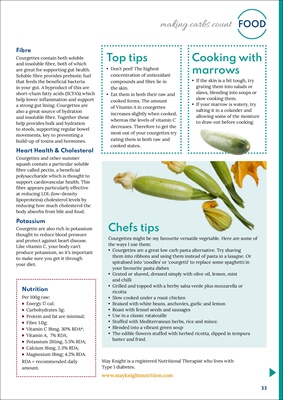
33
FOOD
making carbs count
Nutrition
Per 100g raw:
Energy 17 cal;
Carbohydrates 3g;
Protein and fat are minimal;
Fibre 1.0g;
Vitamin C 18mg, 30% RDA*;
Vitamin A, 7% RDA;
Potassium 261mg, 5.5% RDA;
Calcium 16mg, 2.3% RDA;
Magnesium 18mg; 4.2% RDA.
RDA = recommended daily
amount.
Fibre
Courgettes contain both soluble
and insoluble fibre, both of which
are great for supporting gut health.
Soluble fibre provides prebiotic fuel
that feeds the beneficial bacteria
in your gut. A byproduct of this are
short-chain fatty acids (SCFA's) which
help lower inflammation and support
a strong gut lining. Courgettes are
also a great source of hydration
and insoluble fibre. Together these
help provides bulk and hydration
to stools, supporting regular bowel
movements, key to preventing a
build-up of toxins and hormones.
Heart Health & Cholesterol
Courgettes and other summer
squash contain a particular soluble
fibre called pectin, a beneficial
polysaccharide which is thought to
support cardiovascular health. This
fibre appears particularly effective
at reducing LDL (low-density
lipoproteins) cholesterol levels by
reducing how much cholesterol the
body absorbs from bile and food.
Potassium
Courgette are also rich in potassium
thought to reduce blood pressure
and protect against heart disease.
Like vitamin C, your body can't
produce potassium, so it's important
to make sure you get it through
your diet.
May Knight is a registered Nutritional Therapist who lives with
Type 1 diabetes.
www.mayknightnutrition.com
Chefs tips
Courgettes might be my favourite versatile vegetable. Here are some of
the ways I use them:
• Courgettes are a great low carb pasta alternative. Try shaving
them into ribbons and using them instead of pasta in a lasagne. Or
spiralised into 'zoodles' or 'courgetti' to replace some spaghetti in
your favourite pasta dishes
• Grated or shaved, dressed simply with olive oil, lemon, mint
and chilli
• Grilled and topped with a herby salsa verde plus mozzarella or
ricotta
• Slow cooked under a roast chicken
• Braised with white beans, anchovies, garlic and lemon
• Roast with fennel seeds and sausages
• Use in a classic ratatouille
• Stuffed with Mediterranean herbs, rice and mince.
• Blended into a vibrant green soup
• The edible flowers stuffed with herbed ricotta, dipped in tempura
batter and fried.
Cooking with
marrows
• If the skin is a bit tough, try
grating them into salads or
slaws, blending into soups or
slow cooking them.
• If your marrow is watery, try
salting it in a colander and
allowing some of the moisture
to draw out before cooking.
Top tips
• Don't peel! The highest
concentration of antioxidant
compounds and fibre lie in
the skin.
• Eat them in both their raw and
cooked forms. The amount
of Vitamin A in courgettes
increases slightly when cooked,
whereas the levels of vitamin C
decreases. Therefore to get the
most out of your courgettes try
eating them in both raw and
cooked states.